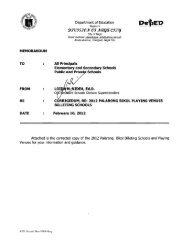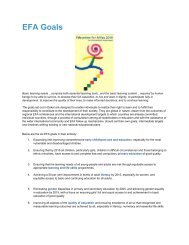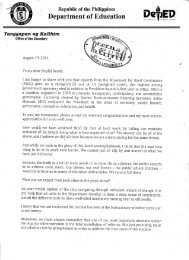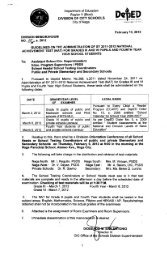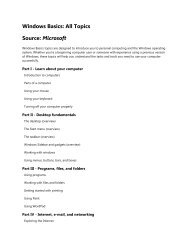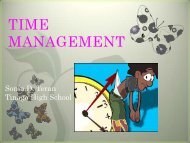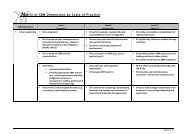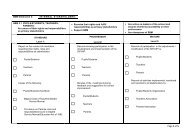science teacher's guide - DepEd Naga City
science teacher's guide - DepEd Naga City
science teacher's guide - DepEd Naga City
You also want an ePaper? Increase the reach of your titles
YUMPU automatically turns print PDFs into web optimized ePapers that Google loves.
Teacher's GuideModule 2: Acids and Basesbasicity of common household items. Similar to Part B, Part C gives thestudents the opportunity to test different water samples from varioussources for acidity or basicity.If you want the class to always have indicator paper available for use,then it is good to ask selected students to work on the following with theguidance of the teacher outside of their class time in Science.Preparing an eggplant/camote acid-base indicator paperNote: You may do this if you need to use an indicator to test samples inother <strong>science</strong> activities.1. Pour the indicator solution prepared in Part A into a shallow plastic orceramic container. (Do not use a metal container.)2. Cover the entire filter or bond paper with the indicator solution bydipping the paper into the solution.3. Air dry for about five minutes. (There is no need to air dry the papercompletely at this point.)4. Repeat procedure numbers 1 and 2 three times or until the color of thepaper becomes dark.5. Continue drying the indicator paper. When the paper is completely dry,cut the paper into small square pieces. This is your indicator paper. Keepit in a covered bottle.6. Label the bottle properly (with name of material and date of preparation).Background Information on IndicatorsThe red, purple, and blue colors of most flowers and some vegetablescontain compounds called anthocyanins. A typical anthocyanin is red inacid, purple in neutral, and blue in basic solution. The eggplant extractshows yellow in a strong base since it contains anthoxanthins (colorless inacid, yellow in base) in addition to anthocyanins. Note that anthocyaninsand anthoxanthins are usually present in many plants. The green color is amixture of blue and yellow. Colors of anthocyanins in neutral to basicGrade 7 Science: MatterDiversity of Materials in the Environment 42




